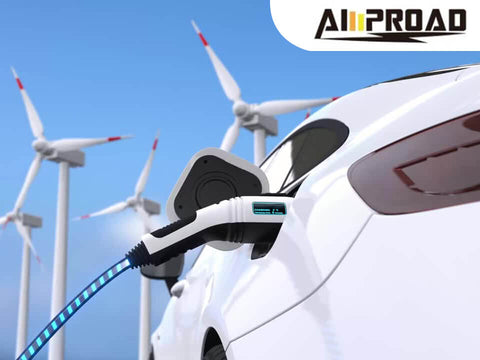
Are you considering installing a Level 2 EV charger at home in the USA? Understanding the costs involved is crucial for making informed decisions. As per the stats on the website of United States Department of Transportation, the installation of a Level 2 EV charger for a single-family house is estimated to be around $1,400 on average. However, this figure can vary based on several factors, including location, charger type, and network connectivity.
When delving into the specifics, it's essential to recognize the main cost drivers. These include the power of the unit, whether it requires a pedestal, and its networking capabilities. Charger type and network connectivity significantly influence hardware costs, which constitute a significant portion of the overall expense. Moreover, installation costs, encompassing labor, materials, permits, taxes, and potential utility upgrades, vary based on location and the number of chargers to be installed.
Understanding these factors can provide clarity on the investment required for integrating a Level 2 EV charger into your home, ensuring seamless charging for your electric vehicle while aligning with your budgetary constraints.
What Are the Main Cost Drivers for Installing a Level 2 EV Charger?
When considering the installation of a Level 2 EV charger at home, it's essential to grasp the main cost drivers. These factors can significantly impact the overall expense, guiding you in budgeting effectively. One primary consideration is the power of the unit. The higher the power capacity, the more expensive the charger tends to be. Additionally, whether the charger requires a pedestal or not can affect costs. Pedestals, which provide support and housing for the charger, typically come with an extra expense attached. Another crucial factor is whether the charger is networked with communication or payment gathering capability. Networked chargers offer advanced features but may come at a higher price tag. Understanding these drivers can help you anticipate and manage the costs associated with installing a Level 2 home EV charger.
What Determines the Hardware Costs of Level 2 EV Chargers?
In addition to the main cost drivers, it's essential to delve into what determines the hardware costs of Level 2 EV chargers. Hardware expenses constitute a significant portion of the overall installation cost and warrant thorough consideration. One key aspect to evaluate is the charger type and its specifications. Level 2 chargers come in various designs with different power capacities, and each variation may have its associated costs. Furthermore, the networking capabilities of the charger can influence hardware expenses. Networked chargers, equipped with communication features or payment gathering capabilities, often command a higher price compared to non-networked counterparts. By carefully assessing these factors, you can gain insights into the hardware costs involved in installing a Level 2 EV charger at home, allowing for informed decision-making and effective budget management.

How Do Charger Type and Network Connectivity Affect Hardware Costs?
Exploring the different types of chargers and their networking capabilities can shed light on hardware expenses. Charger type and network connectivity significantly impact the overall cost of installing an EV charger. The variation in charger types, from basic non-networked units to advanced networked ones, reflects different price points. Additionally, chargers equipped with networking features, such as communication and payment gathering capabilities, tend to be more expensive. Understanding these variations is crucial for homeowners to budget effectively and select the most suitable charger for their needs.
What Are the Installation Costs Associated with Level 2 EV Chargers?
Installation costs encompass labor, materials, permits, taxes, and potential utility upgrades. Let's break down these costs further. Labor costs are influenced by factors such as location and the number of chargers to be installed. Materials required for installation also contribute to the overall expense, including wiring, mounting equipment, and connectors. Permit fees, essential for complying with local regulations, add to the upfront costs. Taxes imposed on installation services further increase expenses. Additionally, utility upgrades, such as electrical panel enhancements or wiring modifications, may be necessary to accommodate the charging infrastructure. By considering each of these components, homeowners can gain a comprehensive understanding of the installation costs associated with Level 2 charger.
When assessing the impact of charger type on hardware costs, it's essential to consider the features and specifications of each option. Basic non-networked chargers offer straightforward functionality but may lack advanced capabilities such as remote monitoring or payment integration. On the other hand, networked chargers provide enhanced functionality but come at a higher price. The choice between these options depends on the homeowner's preferences and requirements.
Installation costs can vary significantly depending on the complexity of the project and the specific requirements of the location. Labor costs typically represent a substantial portion of the total expense, particularly if extensive electrical work is needed. Materials, including charging equipment, wiring, and mounting hardware, also contribute to the overall cost. Permit fees vary by jurisdiction but are necessary for ensuring compliance with local regulations. Taxes imposed on installation services further add to the upfront costs. In some cases, utility upgrades may be required to support the additional electrical load of the charging infrastructure.
How Do Installation Costs Vary Based on Location and Number of Chargers?
Understanding regional differences and the number of chargers per site is crucial for estimating installation expenses accurately. Installation costs can vary significantly depending on the location and the number of chargers to be installed. In densely populated areas with high labor costs, installation expenses may be higher compared to rural areas. Similarly, installing multiple chargers at a single site can lead to economies of scale, reducing the cost per charger. Conversely, installing a single charger at multiple locations may increase overall expenses due to duplication of labor and materials.
Are Home Charging Costs Comparable to Public Charging Costs?
Comparing home charging costs to those of public chargers provides perspective on affordability and convenience. Home charging is generally more cost-effective than public charging, for example charging at Tesla destination charger, primarily due to lower electricity rates and the absence of charging station fees. Additionally, charging at home offers greater convenience and flexibility, as EV owners can plug in their vehicles overnight and wake up to a fully charged battery. However, public charging may be necessary for EV owners who require on-the-go charging or do not have access to home charging facilities. While public charging stations incur additional costs, such as station fees and potentially higher electricity rates, they provide a valuable service for EV owners who need to charge away from home. Ultimately, the choice between home and public charging depends on individual preferences, lifestyle, and driving habits.
Installation costs for portable EV charger can vary depending on several factors, including location and the number of chargers being installed. In urban areas with high labor costs, installation expenses may be higher compared to rural areas. Similarly, installing multiple chargers at a single site can lead to cost savings due to economies of scale, while installing a single charger at multiple locations may increase overall expenses.
Comparing the costs of home charging to those of public charging provides valuable insight into the affordability and convenience of each option. Home charging is generally more cost-effective due to lower electricity rates and the absence of charging station fees. Additionally, charging at home offers greater convenience and flexibility, as EV owners can plug in their vehicles overnight. However, public charging may be necessary for EV owners who require on-the-go charging or do not have access to home charging facilities. While public charging stations may incur additional costs, they provide a valuable service for EV owners who need to charge away from home.
What Factors Influence Home Charging Costs?
Various factors, including home type and charger upgrades, impact the cost of installing EV chargers at home.
How Do Costs Differ Based on Home Type?
The type of residence, whether detached houses, attached houses, or apartments, can influence installation expenses. Detached houses typically have lower installation costs compared to attached houses and apartments. This is because detached houses often have easier access to electrical panels and fewer structural limitations. Conversely, attached houses and apartments may require more complex installation processes, resulting in higher expenses. Additionally, the number of structure penetrations and circuit distance in attached houses and apartments can further increase installation costs.
How Do Level 1 and Level 2 Charger Upgrades Compare in Cost?
Exploring the cost variations between Level 1 and Level 2 charger upgrades can help homeowners make informed decisions. Level 1 chargers utilize standard 120-volt outlets and are typically less expensive to install compared to Level 2 chargers. However, Level 1 chargers have lower charging speeds, resulting in longer charging times. On the other hand, Level 2 charging requires specialized 240-volt outlets and involve higher installation costs. Despite the higher upfront expense, Level 2 chargers offer faster charging speeds, making them more convenient for EV owners. When deciding between Level 1 and Level 2 charger upgrades, homeowners should consider their charging needs, budget, and long-term convenience.
How Does Location Affect Level 2 Charger Upgrade Costs?
Understanding how location influences charger upgrade costs can aid in budgeting for home EV charging solutions. Installation costs can vary depending on regional labor rates, permitting requirements, and utility regulations. In areas with higher labor costs, such as major cities, charger upgrade expenses may be higher compared to rural areas. Additionally, permitting requirements and utility regulations can impact installation costs. Some regions may require additional permits or utility upgrades to install Level 2 chargers, further increasing expenses. By considering these factors, homeowners can better estimate the total cost of upgrading to a Level 2 charger and plan accordingly.
The cost of installing EV chargers at home can vary based on several factors, including the type of residence and the chosen charger upgrades. Detached houses typically have lower installation costs compared to attached houses and apartments due to easier access to electrical panels and fewer structural limitations. Conversely, attached houses and apartments may require more complex installation processes, resulting in higher expenses.
Exploring the cost variations between Level 1 and Level 2 charger upgrades is essential for homeowners. Level 1 chargers are typically less expensive to install but offer slower charging speeds, while Level 2 chargers involve higher installation costs but provide faster charging. Homeowners should consider their charging needs, budget, and long-term convenience when deciding between the two options.
Location plays a significant role in determining charger upgrade costs. Regional labor rates, permitting requirements, and utility regulations can impact installation expenses. Areas with higher labor costs may have higher charger upgrade expenses, while additional permits or utility upgrades may be required in some regions, further increasing costs. By understanding how location influences charger upgrade costs, homeowners can better plan and budget for their home EV charging solutions.



